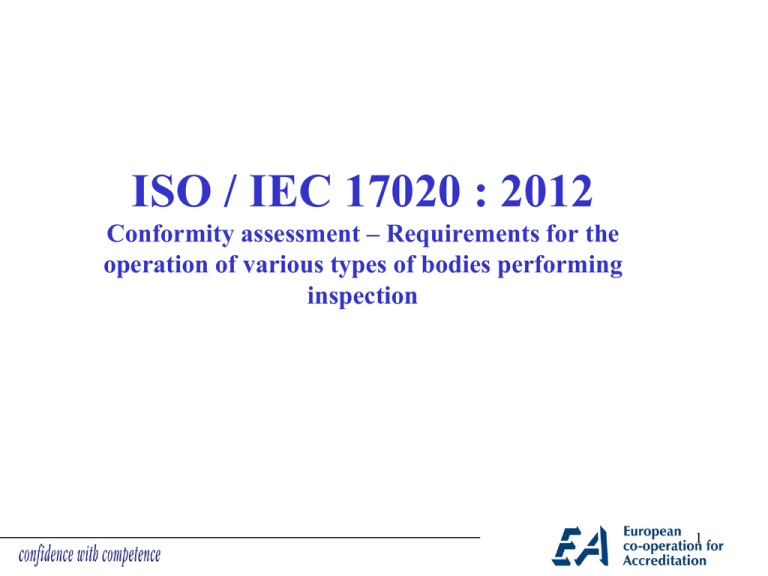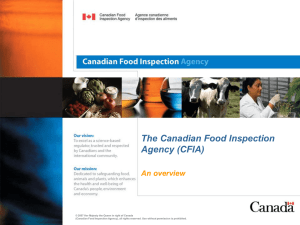overview of the key elements
advertisement

ISO / IEC 17020 : 2012 Conformity assessment – Requirements for the operation of various types of bodies performing inspection 1 Introduction • • • • • • • Clarification of definition in 2nd and 3rd paragraph Requirements can be interpreted when applied to particular sectors The overlapping with testing and certification mentioned An activity embedded in a larger process Providing information with no determination of conformity with requirements A, B and C is a measure of independence Shall, should, may and can Scope, Norm Refs, Terms 1. Scope • Competence, impartiality and consistency • The stages of inspection 2. Normative references • ISO/ IEC 17000 3. Terms and definitions • Inspection and Notes • Product s are not only engineering products • Inspection system and inspection schemes • Impartiality and notes • Appeal and complaint 4 GENERAL REQUIREMENTS 4.1 Impartiality & independence • • • • • • Risks to impartiality on an on – going basis Top management commitment Independent to the extent that is required with regard to conditions under which it performs inspection Third party – Type A First party or second party or both – separate, identifiable and supplies to parent - Type B First party or second party or both – identifiable but not necessarily separate - supplies to parent / others – Type C 4.2 Confidentiality • • • • Legally enforceable commitment Information placed in the public domain Releasing confidential information Information about the client obtained from other sources 5 STRUCTURAL REQUIREMENTS 5 Structural Requirements 5.1 Administrative requirements • Legal entity or part of a legal entity • Adequate provision to cover liabilities • Contractual conditions 5.2 Organisation and management • Structured and managed to safeguard impartiality • Organised and managed to maintain capability to perform inspection • Note regarding exchange of information with other inspection bodies • Technical manager(s) & deputies (discuss ‘one person inspection bodies’) • Description of the job(s) 6 RESOURCE REQUIREMENTS 6. 1 Personnel • • • • • • • • Defined competence requirements Sufficient number of persons Qualifications, training, experience and knowledge Selecting, training formally authorising and monitoring Monitoring Records Remuneration of inspectors All personnel ( including sub –contractors) to act impartially and maintain confidentiality 6.2 Facilities & equipment • • • • • • • • • • • Suitable and adequate facilities and equipment Rules Equipment having a significance influence on the results of inspection Identification Calibration Traceability to national, international standards Reference standards Suppliers, in coming goods and storage Computers and automated equipment Integrity and security of data Defective equipment 6.3 Sub contracting • • • • • • IB shall itself normally perform inspections Sub contractor must be competent Note: contracting in people is not sub contracting Inform the customer Responsibility for determination of conformity rests with the inspection body Records of competence of sub contractors 7 PROCESS REQUIREMENTS 7.1 Inspection methods & procedures • • • • • • • • Inspection requirements, methods and procedures Documented instructions, sampling procedures Non-standard methods Contract or work order control system Verification of information supplied by others Recording of observations made during inspection Calculations and data transfer Carrying out inspections safely 7.2 Handling inspection samples & items • • • Identification and preparation Notifying abnormalities Procedures to avoid deterioration and damage 7.3 Inspection records • • Record system Traceability of reports and certificates 7.4 Inspection reports &certificates • • • • Retrievable reports / certificates Content of inspection reports (see Annex B for optional elements) Conditions for issuing inspection certificates without including results 7.5 Complaints & appeals • • • • Documented process Availability to interested parties Responsibility for decisions Non discriminatory 7.6 Compliant & appeals process • • • • • The handling process Verifying the information to validate the complaint / appeal Acknowledging receipt, reporting progress and outcome Independence of personnel who make decisions Giving formal notice of the end of the process 8 MANAGEMENT SYSTEM REQUIREMENTS 8.1 Options • A management system that is capable of achieving the consistent fulfilment of the requirements of this international standard ( i.e. ISO / IEC 17020) • Option A – Specified requirements ( 8.3 – 8.8 and 7.5 and 7.6) • Option B – A management system in accordance with the requirements of ISO 9001, and that is capable of supporting and demonstrating the consistent fulfilment of the requirements of this international standard (i.e. ISO / IEC 17020) 8.2 Management system documentation (Option A) • • • • • • • Top management Control of documents Control of records Management review Internal audits Corrective actions Preventive actions Annex A ( Normative) Independence requirements • • • Requirements for inspection bodies ( Type A) Requirements for inspection bodies ( Type B) Requirements for inspection bodies ( Type C) Annex B ( informative ) Optional elements of inspection reports and certificates • Designation of document • Description of the work ordered • What has been omitted • Inspection methods & procedures • Equipment • Sampling methods • Where the inspection was carried out • Environmental conditions • Statement on inspection results • Statement on conditions for reproducing the report • Inspectors mark or seal • Names / identification of those who performed the inspection




